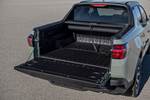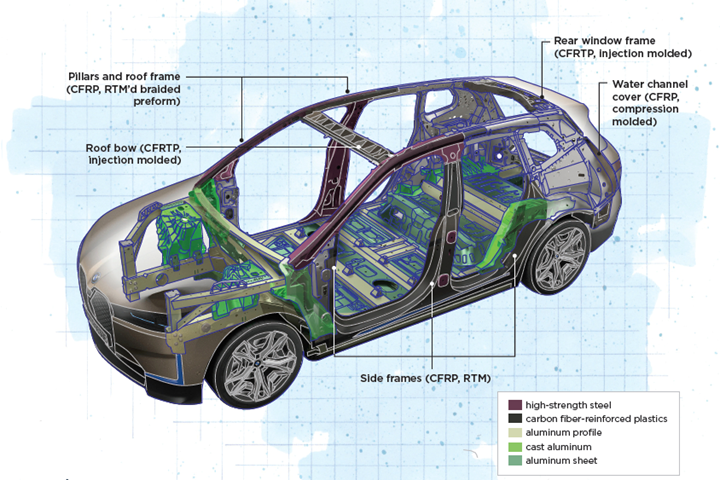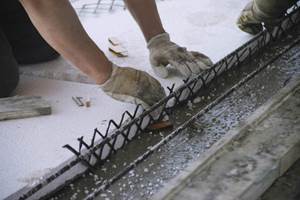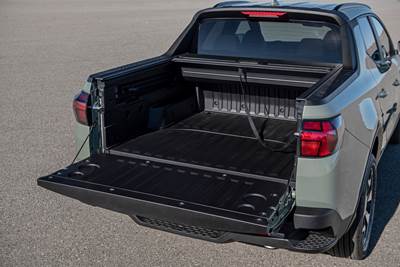Hitting the road in spring 2022, the BMW iX battery-electric sports activity vehicle (SAV) boasts a range of up to 300 miles per charge, powered by two electric motors and a high-voltage, 100 kilowatt-hour (kWh) battery.
The iX builds on BMW Group’s (Munich, Germany) previous developments in electric vehicles (EVs) spanning more than a decade. BMW announced its first composites-intensive electric passenger vehicle in 2010, during JEC World. The all-electric, compact four-door sedan — first called the Megacity and then the i3 on rollout and into today’s production line — features a resin transfer molded (RTM) carbon fiber composite monocoque body called the “Life Module.” Produced at BMW’s Leipzig, Germany production facility, which CW toured in 2014, the i3 and subsequent i8 vehicle Life Modules comprise all-carbon fiber/epoxy structures made from stitched, nonwoven fabrics from partner SGL Group (Wiesbaden, Germany) and recycled carbon fiber, all assembled via robotics.
In 2016, CW visited BMW’s Dingolfing, Germany plant, where the company manufactures the 7-Series luxury sedan, featuring a 16-piece, multi-material “Carbon Core” body. Each component is manufactured via one of four manufacturing processes — wet compression molding, RTM, carbon fiber sheet molding compound (SMC) or as a composite-steel hybrid — and then bonded and riveted to steel components via an automated assembly system.
Announced in November 2020, the iX is BMW’s next foray into composites-intensive, all-EV design, featuring a multi-material body BMW is calling the “Carbon Cage.” “In the iX, the Carbon Core from the 7-Series was combined with the full carbon body from the previous BMW i vehicles, the i3 and i8,” explains Uwe Koehler, senior VP of Body, Exterior and Interior Development at BMW Group.
The vehicle is a hybrid design on the outside as well: The iX is said to be comparable to the BMW X5 mid-size SAV in length and width, almost the same height as the BMW X6 and with wheels the same size as those on the X7.
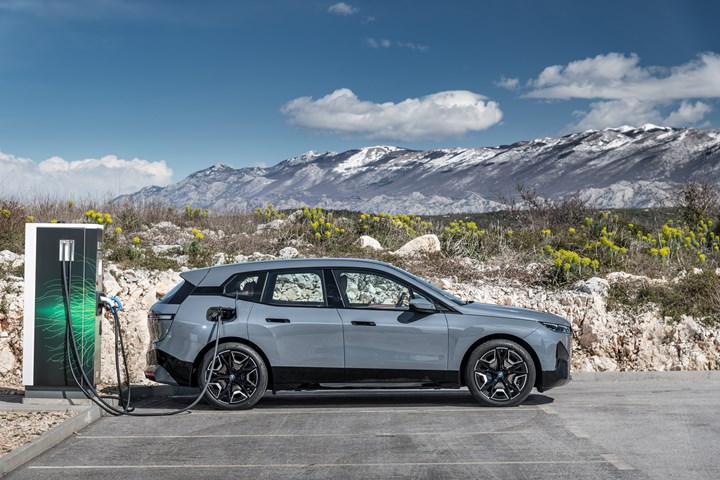
Light weight, long range. For its 2022 battery-electric iX sports activity vehicle (SAV), BMW built on previous composites-intensive i3, i8 and 7-Series vehicle body designs to develop its multi-material “Carbon Cage” body. Thanks in part to its lightweight design, iX is said to have a vehicle range of up to 300 miles per charge. Photo Credit, all images: BMW Group
Lightweight, aerodynamic, multi-material body design
The overall vehicle design targeted aerodynamics, range and — in the shape and finish of the vehicle — minimalism.
BMW calls its multi-material concept an “intelligent lightweight design.” The vehicle (which comes in at a total curb weight of 5,659 pounds/2,566 kilograms) is similar in size to the BMW X5, but the vehicle body shell is said to be 176 pounds/80 kilograms lighter on the iX. The vehicle body comprises carbon fiber-reinforced polymer (CFRP) interior frame and pillar components inside of a metal spaceframe — an aluminum floor assembly, and steel exterior side frames for extra strength and crash protection. Fitting a CFRP side frame instead of a conventional steel part is said to shave several kilograms off the vehicle’s weight. The overall idea is to “reduce weight while increasing body stiffness,” Koehler says, ultimately pushing the vehicle toward maximum efficiency/range and high crash safety.
“Innovative, lightweight design is an essential feature of BMW i vehicles,” he notes. “When it’s used in the right places on the body structure, CFRP offers a high degree of functional advantages. With the iX, we rely on an intelligent material mix with the right materials in the right place.”
Like the 7-Series Carbon Core, the iX Carbon Cage includes CFRP pillars and roof frame. The iX also adds “cross-connections and visible components in the secondary surface area,” Koehler says, including visible side frames, a cutout on the tailgate and water channel covers on the trunk to protect the vehicle interior. All of these composite components use carbon fiber from SGL Carbon SE (Meitingen, Germany) and either epoxy resin or a thermoplastic matrix, Koehler notes.
Manufacture and assembly
The composite components are manufactured by one of three processes: RTM, compression molding or injection molding. All composite components are produced in BMW facilities prior to vehicle assembly at its Dingolfing plant. Johann Kistler, BMW iX project manager, notes that BMW’s production facilities include a “complete in-house value stream from fiber to component, as well as a high degree of automation. This means CFRP components can be manufactured to a high standard at a low cost.”

Multi-material innovation. To optimize performance at the lowest weight possible, the iX employs a mix of materials including thermoset and thermoplastic carbon fiber composites within a metal and aluminum frame.
RTM. Much of the Carbon Cage is manufactured via RTM, including the A-, B- and C-pillars and roof frame components from the front sill to just behind the B-pillar, and the vehicle side frames. A braided CFRP profile is molded with a temporary supporting PET core that is removed after manufacture. During final assembly, the roof and side frame structures are ultimately bonded to an outer steel reinforcement, “for ductility in the highly stressed area,” Koehler says.
Compression molding. The water channel cover toward the back of the vehicle body is wet-pressed.
Injection overmolded CFRTP. For the roof bow and rear window frame, BMW Group decided to overmold CFRP rod preforms with thermoplastic pellets that are reinforced with recycled chopped carbon fibers. Kistler explains that pultruded, CFRP rod preforms “are heated, formed and inserted into the injection mold together with steel adapters,” prior to injection overmolding of a recycled carbon fiber-reinforced thermoplastic. “Injection molding is a well-known process that can be carried out fully automatically at a considerably low cost,” he says. “Properties of the component can be easily adapted via different additives in the thermoplastic.” This process is similar to that done in MAI Skellet, a demonstrator project BMW Group did previously with SGL, where thermoplastic pultrusions were combined with injection overmolding to build an optimized, cost-competitive windshield frame.
This hybrid CFRP-CFRTP construction is said to increase stiffness while achieving a weight savings of 5 kilograms (11 pounds) compared to steel for the same parts, while achieving the slim, simple aesthetic that BMW wanted in order to add a sense of spaciousness to the cabin. The complex shape allows for other components like brackets for control units, washer fluid lines and wiring harnesses to be incorporated into the vehicle frame.
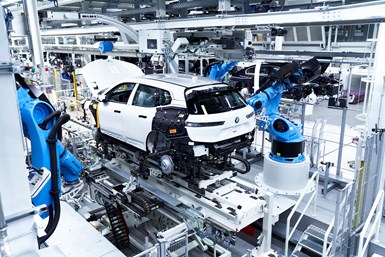
Robotic assembly. All composite components are manufactured at BMW production facilities, then assembled with the rest of the vehicle via bonding and robotic assembly at the company’s assembly site in Dingolfing, Germany. Bottom image shows adhesive being applied to one of the iX’s side frames prior to assembly.
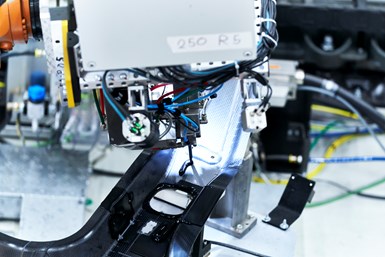
Once all components are manufactured, the Dingolfing facility employs a largely automated robotic assembly for all components. Like the 7-Series and previous i vehicles, CFRP components are joined to the rest of the vehicle via adhesive bonding, with steel inserts attached to the body via spot welding. “With an intelligent selection of adhesives, the joint strength can be designed to optimize rigidity and power transmission,” Kistler says. Ultimately, Kistler says, “The materials selected and manufacturing processes employed are both precisely matched to the requirements of each specific component in order to increase body rigidity and crash safety while keeping weight as low as possible.”
iX on the road
The first customer iX cars will be out on the road beginning in spring 2022. Beyond the Carbon Cage, the iX has also been designed for passenger comfort and convenience, including advanced computing capabilities optimized for automated driving and parking, spacious interior spaces and specially designed seating. BMW Group also experimented with the use of several recycled or natural materials in the vehicle interior, and claims its eDrive technology — encompassing electric motors, charging technology, power electronics and batteries — are built without the use of rare earth metals.
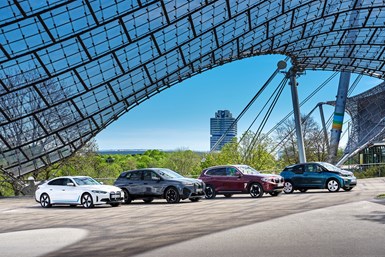
Latest in the i-series. The iX is the fourth in BMW’s i-series of battery-electric vehicles. Pictured left to right are the 2022 i4 sedan, iX SAV, iX3 SAV and i3 compact sedan.
Some of the design thinking used in the iX has also been implemented in new versions of existing composites-intensive BMW models, Koehler notes. For example, the current version of the 7-Series is manufactured with more carbon fiber components than the original design, such as fully CFRP A-, B-, and C-pillars where hybrid metal/CFRP components were used before. He notes, “As a result, the vehicle weight has been reduced by a total of up to 130 kilograms [286 pounds] compared with its predecessor, depending on the version and trim.”
Related Content
Jeep all-composite roof receivers achieve steel performance at low mass
Ultrashort carbon fiber/PPA replaces steel on rooftop brackets to hold Jeep soft tops, hardtops.
Read MoreCarbon fiber composite pallet revolutionizes freight industry
LOG Point Pallet fuses advanced materials with innovative design and manufacturing to improve supply chains worldwide.
Read MoreCarbon fiber, bionic design achieve peak performance in race-ready production vehicle
Porsche worked with Action Composites to design and manufacture an innovative carbon fiber safety cage option to lightweight one of its series race vehicles, built in a one-shot compression molding process.
Read MoreComposites-reinforced concrete for sustainable data center construction
Metromont’s C-GRID-reinforced insulated precast concrete’s high strength, durability, light weight and ease of installation improve data center performance, construction time and sustainability.
Read MoreRead Next
Chevy unveils the 2023 Corvette Z06
The 670-horsepower vehicle continues to make headway aesthetically and performance-wise with composite wheels, wing and aero bits.
Read MoreHyundai selects IDI Composites’ Fortium thermoset material for Santa Cruz truck box
The Fortium series imparts 40-65% discontinuous glass fiber reinforcement with high-strength and impact resistance in “scratch black” for a highly functional truck bed in the 2022 Sport Adventure Vehicle (SAV).
Read MoreDeveloping bonded composite repair for ships, offshore units
Bureau Veritas and industry partners issue guidelines and pave the way for certification via StrengthBond Offshore project.
Read More

.jpg;width=70;height=70;mode=crop)

